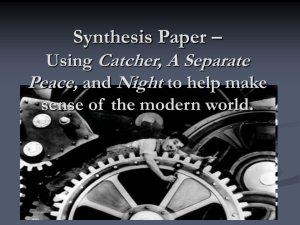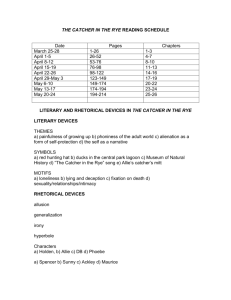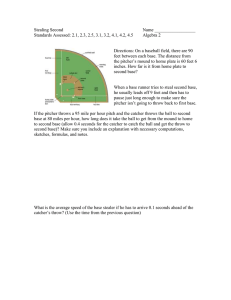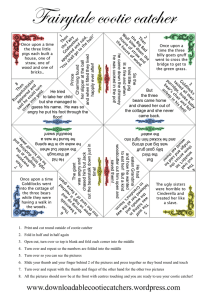Nolan Blakeley December 3, 2012 Economics 3541
advertisement
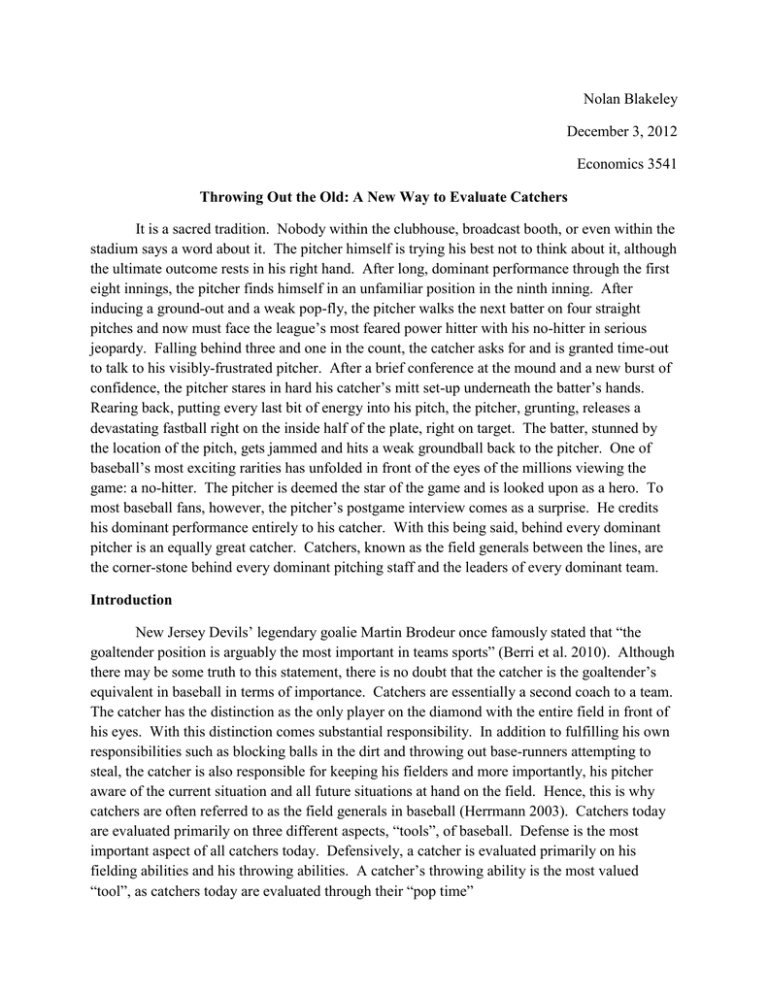
Nolan Blakeley December 3, 2012 Economics 3541 Throwing Out the Old: A New Way to Evaluate Catchers It is a sacred tradition. Nobody within the clubhouse, broadcast booth, or even within the stadium says a word about it. The pitcher himself is trying his best not to think about it, although the ultimate outcome rests in his right hand. After long, dominant performance through the first eight innings, the pitcher finds himself in an unfamiliar position in the ninth inning. After inducing a ground-out and a weak pop-fly, the pitcher walks the next batter on four straight pitches and now must face the league’s most feared power hitter with his no-hitter in serious jeopardy. Falling behind three and one in the count, the catcher asks for and is granted time-out to talk to his visibly-frustrated pitcher. After a brief conference at the mound and a new burst of confidence, the pitcher stares in hard his catcher’s mitt set-up underneath the batter’s hands. Rearing back, putting every last bit of energy into his pitch, the pitcher, grunting, releases a devastating fastball right on the inside half of the plate, right on target. The batter, stunned by the location of the pitch, gets jammed and hits a weak groundball back to the pitcher. One of baseball’s most exciting rarities has unfolded in front of the eyes of the millions viewing the game: a no-hitter. The pitcher is deemed the star of the game and is looked upon as a hero. To most baseball fans, however, the pitcher’s postgame interview comes as a surprise. He credits his dominant performance entirely to his catcher. With this being said, behind every dominant pitcher is an equally great catcher. Catchers, known as the field generals between the lines, are the corner-stone behind every dominant pitching staff and the leaders of every dominant team. Introduction New Jersey Devils’ legendary goalie Martin Brodeur once famously stated that “the goaltender position is arguably the most important in teams sports” (Berri et al. 2010). Although there may be some truth to this statement, there is no doubt that the catcher is the goaltender’s equivalent in baseball in terms of importance. Catchers are essentially a second coach to a team. The catcher has the distinction as the only player on the diamond with the entire field in front of his eyes. With this distinction comes substantial responsibility. In addition to fulfilling his own responsibilities such as blocking balls in the dirt and throwing out base-runners attempting to steal, the catcher is also responsible for keeping his fielders and more importantly, his pitcher aware of the current situation and all future situations at hand on the field. Hence, this is why catchers are often referred to as the field generals in baseball (Herrmann 2003). Catchers today are evaluated primarily on three different aspects, “tools”, of baseball. Defense is the most important aspect of all catchers today. Defensively, a catcher is evaluated primarily on his fielding abilities and his throwing abilities. A catcher’s throwing ability is the most valued “tool”, as catchers today are evaluated through their “pop time” and the subsequent numbers of base-runners thrown-out attempting to steal. Offensively, a catcher is expected to produce runs for his team. Initially, a catcher is evaluated on his raw power. When this raw power has been polished, the catcher is then evaluated by the number of hits he produces, specifically the “big” hits he produces such as home-runs, hits that produce runs (runs-batted-in), and timely hitting ("What are Scouts and College Coaches Looking for in Catchers?" 2005). By today’s standards, the top four catchers in the Major Leagues are (in no specific order) Ryan Hanigan of the Cincinnati Reds, Yadier Molina of the St. Louis Cardinals, Miguel Montero of the Arizona Diamondbacks, and Buster Posey of the San Francisco Giants. When speaking about all-time great catchers, the names Yogi Berra and Johnny Bench are always the first names mentioned. These aforementioned top players, however, are based upon the current system that evaluates catchers. This system includes the arm strength of a catcher and his correlating caught-stealing percentage defensively and offensively, standard batting statistics including batting average, home-runs, and runs-batted in (Herrmann 2003). The current system for evaluating catchers both overlooks and excludes key statistics specific to catchers. The new system for catchers will help better determine the best current catchers in Major League Baseball and the greatest all-time catchers. The new system, unlike the old system, will also help front office management, clubhouse management (MLB managers and coaches), and scouts better determine the catchers that help produce wins for a franchise. Literature Review The Role of Catchers Catchers are the backbone of every baseball team. They are most vital to a team’s success and endure the most responsibility on the diamond. The role of catchers is split between two categories, which are defensive responsibilities and offensive responsibilities. Defense is the most crucial aspect of a catcher’s game. The defensive responsibilities of a catcher are divided into two groups, which are pitching and fielding (Miller 2005). “Pitching is such a huge part of the game and catchers are so important to pitching (Miller 2005). Catchers are the only players that deal with the pitcher every pitch. It is vital for a catcher to know both the current situation and his pitcher’s strengths and weaknesses (Miller 2005). For instance, the catcher must know the scouting reports on each opposing batter, each batter’s history against the current pitcher, each batter’s tendencies, and the pitcher’s strengths in all situations (Edes 2005). The most vital aspect of pitching that a catcher is responsible for is building and maintaining a positive relationship with each pitcher. Pitcher-catcher relationships are essential for winning baseball teams. It is the catcher’s primary duty to stay positive through every situation and moreover, to keep his pitcher thinking positively and helping him get through each inning and each game one pitch at a time (Miller 2005). In essence, a catcher’s leadership and knowledge of his pitchers are the core responsibilities for catchers in terms of pitching. From a fielding standpoint, catchers are valued on their arm strength and their on-field leadership. A catcher’s “pop-time” (explained in next section) directly correlates to the number of base-runners he throws out attempting to steal. Catchers are judged primarily on this ability to throw-runners out attempting to steal from a fielding standpoint. A catcher’s on-field leadership skills are also vital to all of his defensive players. Catchers know all the defensive plays (Miller 2005). “Fielders look for a flash of fingers that will help them anticipate a play” (Edes 2005). Also vital to a catcher’s fielding skills are his ability to block balls in the dirt and field bunts (Herrmann 2003). From fielders and pitchers to opposing batters, umpires, and managers, catchers must be involved in every aspect of the game and be equally aware of it and any future possible situations (Miller 2005). There was once a time when great catchers were simply great defensive catchers and mediocre hitters are best. The times, however, have changed. Catchers today are expected to fulfill all of their defensive duties AND produce substantial offensive output (Herrmann 2003). The primary offensive duty of catchers is to produce runs. These statistics come in the form of home-runs, runs-batted in, and timely hitting, such as sacrifice flies and executing during certain situations like the hit-and-run. Most Major League catchers hit for a mediocre average every year (between .240-.270) while stealing very few bases, but producing a great amount of runs made possible by their raw power (Miller 2005). Current Evaluation System for Catchers Although the role of catchers is broken down into pitching, fielding, and hitting, the current system for evaluating catchers only takes into account fielding and hitting. In terms of fielding, arm strength is everything. A catcher’s “pop time” directly correlates to a catcher’s arm strength. “Pop time” is the allotted time it takes for the ball to hit the catcher’s mitt after a pitch is thrown to when the ball is caught at second base. In the Major Leagues, the average catcher has a “pop time” between 1.8 seconds and 2 seconds (Herrmann 2003). The “pop time” of a catcher is connected to the amount of attempted base-stealers a catcher throws out, better known as “caught stealing percentage” ("What are Scouts and College Coaches Looking for in Catchers?" 2005). Caught stealing percentage is equivalent to the number of base-stealers a catcher throws out over the total number of base-stealers (Baseball Reference 2012). From hitting perspective, a catcher is evaluated on his raw power and the subsequent number of runs he produces. The number of runs produced by a catcher today is evaluated through the standard batting statistics of home-runs and runs-batted in (Herrmann 2003). The number of runs scored by a catcher, however, is not evaluated by the current system. The short-comings of the current system make it easy for scouts and front-office management to misjudge Major League catchers today. New Evaluation System for Catchers The new evaluation system for catchers builds upon some of the already-existent aspects of the current system and incorporates vital statistics that the current system excludes. Defensively, a catcher will be evaluated through two statistics. From a fielding standpoint, the catcher’s caught-stealing percentage will still be incorporated because despite how well a catcher calls a game and how well a pitcher executes, base-runners are still bound to reach base during the course of a baseball game. As mentioned before, the leadership and knowledge of a catcher is vital to a team’s pitching. The current system, however, does not measure the pitching responsibilities of a catcher. With the new system, catcher’s earned-run average will be incorporated. Catcher’s earned-run average is essentially the total number of earned runs a team’s pitching staff surrenders with the same catcher behind the plate over a nine inning game (Baseball Reference 2012). From an offensive standpoint, a catcher will be evaluated through three unique statistics that help measure the total amount of runs a catcher produces. The first statistic, which is often overlooked, is on-base percentage. Unlike a standard batting average, on-base percentage is the percentage of times a batter reaches base, including base on balls, hitby-pitch, or reaching on an error or fielder’s choice (Baseball Reference 2012). This statistic is essential because the more a catcher (or any player for that case) reaches base, the more likely he is to score. The second statistic incorporated into the new system is called “total runs produced”. This statistic takes all the runs-batted in a catcher produces and all the runs scored by the same catcher and adds the numbers together. Therefore, this helps even-out the players who may produce few runs-batted in, but score a great number of runs or vice versa. In other words, catchers who produce an all-around number of runs are the more valuable to teams than runsbatted-in machine catcher that never gets on base and scores as well. The final unique statistic measures the efficiency of catchers producing runs through runs-batted in. This statistic is called the “runs-batted in to hits ratio”. This statistic is similar to the “home-runs to at-bat ratio”. The RBIs-Hits ratio is the total number of hits it takes to produce one run-batted in. The closer the number of hits is to one run-batted in, the more efficient the catcher is. The defensive statistics, through measuring the most important aspects of pitching and fielding, and the offensive statistics, through measuring the overall ability of a catcher to produce runs, will effectively reevaluate the best current catchers in the Major Leagues as well as all-time catchers and subsequently link these catchers to the success of their respective teams. Theory The new system for evaluating catchers looks to accomplish two objectives. The first objective is to evaluate all vital aspects of a catcher’s game that the current system omits. This includes the implementation of catcher’s ERA into defensive aspects evaluated and the three batting statistics used to measure a catcher’s overall ability to produce runs for his team. The second objective is to find any relationship between the overall ranking of a catcher based upon the new system and the corresponding success of his team. In other words, does a catcher’s defensive abilities and ability to produce runs relate to the number of games a team wins? There are some obvious short-comings with this new system such the omission of a catcher’s fielding percentage and OPS (On-Base Percentage plus Slugging Percentage), but the main objective of the new system is to break-down a catcher’s responsibilities into the three broad categories of pitching, fielding, and hitting and analyze these objectives through category-specific statistics. Model The new system uses a simple scale-based system constructed through the break-down of the five major statistics used to evaluate catchers. These five statistics are broken down by different number segments and rated on a scale of one to ten. One is the best possible score while ten is the worst and between five and six is average. Once these scores are calculated, the catcher’s total defensive score is added to the total offensive score for an overall total score. The best possible score for a catcher to obtain is five and the worst possible score to obtain is fifty. In other words, the lower the overall score, the higher ranked the catcher will be. All minimum requirements for certain statistics will be stated if and when they arise in the data. The data will reveal the following items: the top five catchers in the MLB for the 2012 season, the top five catchers in the American League for the 2012 season, the top five National League catchers for the 2012 season, the top five Hall-of-Fame catchers, and the top ten catchers of all-time. Please note that the catchers for 2012 and the top ten all-time catchers both have minimum requirements to make a catcher eligible. Below is the criteria used to evaluate the catchers: Rank 1 2 3 4 5 6 7 8 9 10 RBI to Hits Ratio* RBI-Hits 1.50 & Below 1.51-1.55 1.56-1.60 1.61-1.65 1.66-1.70 1.71-1.75 1.76-1.85 1.886-2.00 2.01-2.19 2.20 & Above *Min 350 PA/90 Games Rank 1 2 3 4 5 6 7 8 9 10 On-Base Percentage OBP .400 & Above .375-.399 .360-.374 .340-.359 .330-.339 .315-.329 .300-.314 .290-.299 .275-.289 .274 & Below 1 2 3 4 5 6 7 8 9 10 Total Runs Produced (2012 Scale) TRP (RBIs + Runs) 170 & Above 150-169 130-149 120-129 110-119 100-109 80-99 60-79 50-59 49 % Below 1 2 3 4 5 6 7 8 9 10 Total Runs Produced (Career) TRP (RBIs + Runs) 2500 & Above 2300-2499 2200-2299 2100-2199 2000-2099 1900-1999 1800-1899 1600-1799 1200-1599 1199 & Below Rank Rank 1 2 3 4 5 6 7 8 9 10 Catcher's Earned Run Average Catcher's ERA 3.00 & Below 3.01-3.25 3.26-3.50 3.51-3.75 3.76-4.00 4.01-4.25 4.26-4.50 4.51-4.75 4.76-5.00 5.01 & Above 1 2 3 4 5 6 7 8 9 10 Caught-Stealing Percentage CS % 45% & Above 40-44% 35-39% 30-34% 25-29% 20-24% 17-19% 15-16% 11-14% 10% & Below Rank Rank After a rank is assigned for each category for each individual player, the offensive ranks are added together to obtain a total offensive rank and the defensive ranks are added together to obtain a total defensive rank. Finally, the total offensive rank is added to the total defensive rank to obtain a final overall score. Raw Data (No Analysis) The following is the raw data computed from the aforementioned model. There are issues to point out for each set of data. For the 2012 season catcher qualifiers, both Joe Mauer and Jose Molina are included. Mauer exceeded the minimum plate appearances required to qualify and played in 147 total games. Only 74 of those games, however, were as a catcher. Molina exceeded the minimum games required to qualify, but missed the total number of plate appearances by 50. Neither player affected the desired results. Also, although there are 13 Hall-of-Fame catchers listed, there are actually 15 enshrined in Cooperstown. The lack of Negro League data necessary to compute this however, however, omitted Biz Mackey and Josh Gibson from this list. Finally, in order to be eligible for the top all-time catchers, the player had to have a minimum of 8500 plate appearances and play between 1950 up until the present. This is mostly because the Catcher’s ERA from 1950 until the present is much more accurate and reliable than pre-1950. 2012 Eligible Catcher’s Stats Total Offensive Score Player & Team Total Defensive Score Total Score Miguel Montero (ARI) 7 7 14 Yadier Molina (STL) 5 15 20 Matt Wieters (BAL) 8 11 19 A.J. Ellis (LAD) 7 19 26 Russell Martin (NYY) 12 18 30 A.J. Pierzynski (CHW) 11 15 26 Kurt Suzuki (OAK) 8 27 35 Brian McCann (ATL) 9 14 23 Buster Posey (SF) 8 8 16 Alex Avila (DET) 8 14 22 Ryan Hanigan (CIN) 3 22 25 Carlos Ruiz (PHL) 10 13 23 John Buck (MIA) 10 20 30 Wilin Rosario (COL) 14 12 26 Jarrod Saltalamacchia (BOS) 16 16 32 Jose Molina (TB)* 6 24 30 Carlos Santana (CLE) 13 11 24 Josh Thole (NYM) 11 28 39 Rod Barajas (PIT) 14 26 40 Geovany Soto (CHC) 12 21 33 J.P. Avencibia (TOR) 14 16 30 Joe Mauer (MIN)** 18 12 30 *Molina caught the minimum number of games, but did not reach the minimum number of plate appearances **Mauer reached the minimum number of plate appearances, but did not meet the minimum number of games caught ***All offensive stats obtained from ("MLB Player Batting Stats -2012" 2012) **** All defensive stats obtained from ("MLB Player Fielding Stats - 2012" 2012) Top 5 MLB Catchers 2012 Player & Team Miguel Montero (ARI) Buster Posey (SF) Matt Wieters (BAL) Yadier Molina (STL) Alex Avila (DET) Total Offensive Score Total Defensive Score 7 8 8 5 8 Total Score 7 8 11 15 14 14 16 19 20 22 Top 5 American League Catchers 2012 Player & Team Matt Wieters (BAL) Alex Avila (DET) Carlos Santana (CLE) AJ Pierzynski (CHW) Russell Martin (NYY) J.P. Avencibia (TOR) Total Offensive Score Total Defensive Score 8 8 13 11 12 14 Total Score 11 14 11 15 18 16 19 22 24 26 30 30 Top 5 National League Catchers 2012 Player & Team Miguel Montero (ARI) Buster Posey (SF) Yadier Molina (STL) Carlos Ruiz (PHL) Brian McCann (ATL) Total Offensive Score Total Defensive Score 7 8 5 10 9 Total Score 7 8 15 13 14 14 16 20 23 23 Hall of Fame Catcher’s Stats Total Offensive Total Player Total Defensive Score Score Score Johnny Bench 6 7 13 Yogi Berra 4 6 10 Roger Bresnahan 7 21 18 Roy Campanella 6 13 19 Gary Carter 6 13 19 Mickey Cochrane 8 16 24 Bill Dickey 6 10 16 Buck Ewing 9 16 24 Rick Ferrell 7 22 19 Carlton Fisk 9 12 21 Gabby Hartnett 6 12 18 Ernie Lombardi 6 20 26 Ray Schalk 6 24 30 *Negro League statistics were not available - thus, excluding Josh Gibson & Biz Mackey from this list ** All stats obtained from ("Stats for Hall of Fame Catchers" 2012) Top 5 Hall of Fame Catchers Player Yogi Berra Johnny Bench Bill Dickey Gabby Hartnett Gary Carter Roy Campanella Total Offensive Score Total Defensive Score 4 6 6 6 6 6 6 7 10 12 13 13 Total Score 10 13 16 18 19 19 All-Time Eligible Catcher’s Stats* Player Total Defensive Score Total Offensive Score Ted Simmons 8 Mike Piazza 11 Johnny Bench 6 Carlton Fisk 9 Gary Carter 6 Yogi Berra 4 Ivan Rodriguez 9 Lance Parrish 8 Jorge Posada 12 Benito Santiago 8 Bob Boone 7 Darrell Porter 8 Elston Howard 5 Bill Freehan 7 Jason Varitek 12 Terry Steinbach 10 Jason Kendall 12 A.J. Pierzynski 12 Tony Pena 7 Thurman Munson 5 Tim McCarver 6 Jim Sundberg 7 Brad Ausmus 9 *Minimum 5800 Plate Appearances **Player had to have caught from 1950-present *** All stats obtained from (Baseball Reference 2012) Total Score 12 7 7 12 13 6 15 18 12 23 25 18 23 22 19 23 21 25 26 23 24 25 25 20 18 13 21 19 10 24 26 24 31 32 26 28 29 31 33 33 37 33 30 30 32 34 Top 10 Eligible Catchers of All-Time Total Defensive Player Score Yogi Berra* 4 Johnny Bench* 6 Mike Piazza 11 Gary Carter* 6 Ted Simmons 8 Carlton Fisk* 9 Ivan Rodriguez 9 Jorge Posada 12 Lance Parrish 8 Darrell Porter 8 Elston Howard 5 *Denotes Hall of Fame Player Total Offensive Score 6 7 7 13 12 12 15 12 18 18 23 Total Score 10 13 18 19 20 21 24 24 26 26 28 Results (Concrete Analysis) The data yielded by the new system produced some effective results. Of the top five catchers in the Major Leagues for the 2012 season, two out of the five catcher’s teams reached the World Series, with Posey’s Giants capturing the World Series. Four out of the five top five MLB catcher’s teams made the postseason with Montero’s Diamondbacks just missing the wild-card spot in the National League. Out of the American League’s top catchers, three of the six catcher’s teams (there was a tie for fifth ranking) made the playoffs while three out of the five National League’s top catchers made the playoffs. Between the top eleven catchers (Top five AL and top five NL) from both leagues, six of the catcher’s teams made the playoffs while only two of the catcher’s teams finished in last place in their respective divisions. The top Hall of Fame catchers of all-time did not produce strikingly different results than the old system. Yogi Berra, often mentioned as one of the greatest catchers of all-time, ranked first and more importantly, in front of Johnny Bench, who, by measures of the old system and baseball experts past and present, is typically regarded as THE greatest catcher of all-time. In terms of the top ten alltime great catchers, all of the catchers ranking within the top ten played for successful teams during their time. Conclusions (In-Depth Analysis & Outstanding Questions) Based upon the data gathered from the new system for evaluating catchers, it is uncertain whether the new system better measures catchers than the current system. Although the new system incorporates more specific statistics than the current system, the catching rankings were not significantly altered. There is enough substantial evidence, however, that the new system correlates with the success of a catcher’s teams. According to the data, the second-ranked and fifth-ranked catchers (Buster Posey and Alex Avila, respectively) squared off in the World Series. With fifty-five percent of the top eleven catcher’s teams making the playoffs and more than seventy-percent of the catcher’s teams finishing second place or higher in their respective divisions, the new system undoubtedly ties overall catching performance to a team’s success. This is also evident in the top ten all-time catchers, with players such as Yogi Berra, Johnny Bench, Ivan Rodriguez, and Jorge Posada winning multiple World Series rings with their respective teams. This data gathered by the new system also brings forth numerous questions. One question relates to the value of a catcher to his team. This is exemplified by simply looking at top two MLB catchers for the 2012 season. Although Miguel Montero was evaluated as the best catcher in the Major Leagues for the 2012 season by the new system, the number two catcher, Buster Posey, won the National League’s Most Valuable Player award. Therefore, an issue to expand on in the future while constructing another system or incorporating into the new system (other than the mind-boggling WAR statistic) is a way to evaluate a catcher’s specific value to his team and the corresponding wins he helped produce. An issue with the data for the top Hall-of-Fame catchers was the unreliability of the catcher’s ERA computed before Roy Campanella began playing in the Major Leagues. If the data were more reliable and altered, this would significantly affect the rankings of the Hall-of-Fame catchers. Finally, when ranking the top ten players of all-time from 1950 until the present (once again, reliable Catcher’s ERA came about around 1950), although the four Hall of Famers from that time period made the top ten, some players rank in front of the Hall of Famers. This raises several questions. For one, is this new system an effective way to evaluate catchers’ Hall of Fame worthiness? If so, will this help borderline Hall-of-Fame players such as Jorge Posada enter the Hall of Fame? Why is a player like Ted Simmons, who played during the same time period as Johnny Bench and Carlton Fisk, in the Hall of Fame with the rating the new system produced for him? Do the results yielded for players like Mike Piazza and Pudge Rodriguez nearly automatically enshrine as baseball gods in Cooperstown? One last way to utilize the new system would be to break-down the top ten all-time catcher’s seasons throughout their careers and compare their corresponding year’s season to the current number of seasons the top five Major League catchers of 2012 have individually played. For instance, because this is Buster Posey’s third full season in the Major Leagues, break down each of the top ten all-time catcher’s third season and before and compare them to Posey’s. This way, comparisons can be drawn between current and past catchers and predictions can also be made for the current great catchers. In essence, although the new system for evaluating catchers is only slightly more effective for evaluating catchers than the current system, it undoubtedly links the connection between the top catchers in the league and the overall success of a team, whether currently or in the past.
